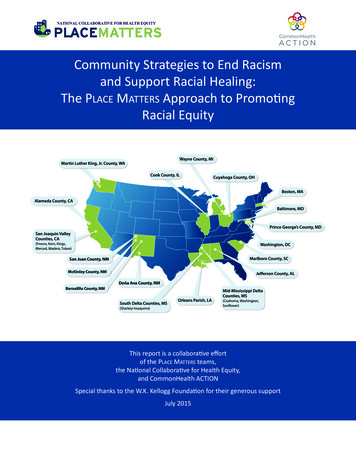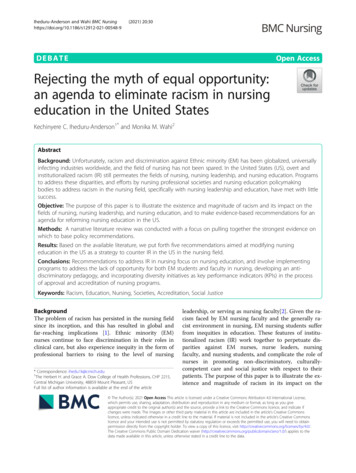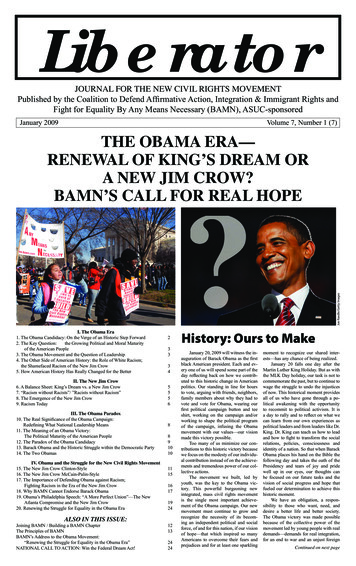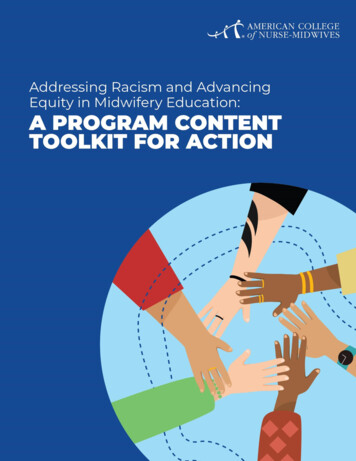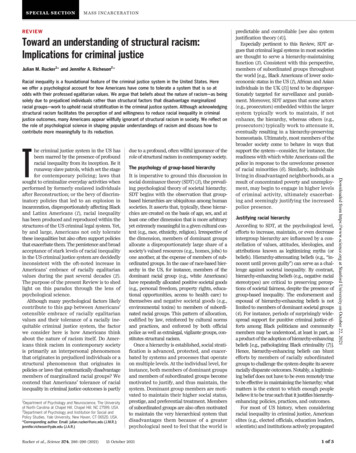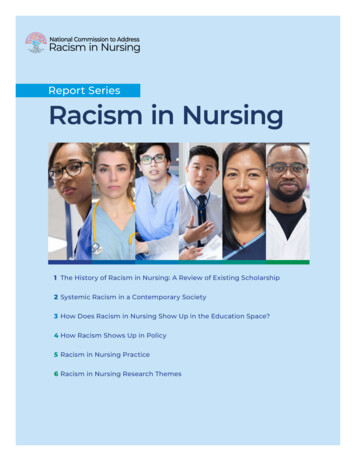
Transcription
Report SeriesRacism in Nursing1 The History of Racism in Nursing: A Review of Existing Scholarship2 Systemic Racism in a Contemporary Society3 How Does Racism in Nursing Show Up in the Education Space?4 How Racism Shows Up in Policy5 Racism in Nursing Practice6 Racism in Nursing Research Themes
REPORT SERIESReport #1 of 6The History of Racism in Nursing:A Review of Existing ScholarshipDominique Tobbell, Ph.D., andPatricia D’Antonio, Ph.D., RN, FAANMay 1, 2022
Report #1 of 6The History of Racism in Nursing:A Review of Existing Scholarship3Introduction5Nursing’s Origin Story8Racism and War11Nursing and the Era of Enslavement17Nursing and Colonialism in the Indigenous United States28Nursing and American Imperialism Beyond the Continental U.S.30Intersections of Imperialism and Racism in Latino Nursing33Imperialist Legacy36The Limits of Integration and the Need for Activism43Conclusion
IntroductionHistory matters. Beyond George Santayana’s oft-repeated cliche that “those who cannotremember the past are condemned to repeat it,” history – or more correctly, the storieswe tell about our history – frames how we think about ourselves now and the possibilitieswe can imagine for our future.1 These stories have their own power. They create a sharedsense of identity. They can remain essential yet change over time in small but powerfulways to incorporate new questions and new issues. And they can construct meaningsthat sometimes bridge even if they cannot destroy divides based on what scholars havedescribed as “positionality”: where one stands vis-a-vis backgrounds, assigned roles, socialconstructs, political capital, and sheer ambition.We acknowledge our own positionality. We are both white women. We are also,respectively, the director of the Eleanor Bjoring Center for Nursing Historical Inquiry atthe University of Virginia and the director of the Barbara Bates Center for the Study ofthe History of Nursing at the University of Pennsylvania. As such, we are experts in broadareas of the history of nursing and healthcare as well as in the narrower areas of our ownexpertise. We believe deeply in the power of history and historical analysis; we believeboth give scholars and readers the distance of time to step back and reflect upon difficultand contentious issues. Historical concepts and methods reflect the complexity andinterconnectedness of critical political, social, and cultural issues that cannot be reduced tosingle variables. They attend to the importance of context and causality. They link ideas andactors in interpretive narratives of meaning; as such, there can be no overarching ”story”but, rather, different ones that privilege different perspectives.2 And, most important, theyencourage formulation of judgments and assessments of significance.3G. Rumay Alexander, Katie Boston-Leary, and Cheryl Peterson, representing the NationalCommission to Address Racism in Nursing, commissioned this essay. The timeline theypresented that would best enable this essay to move the Commission’s work forwardprecluded original research. We have thus constructed what we call an historiographicalessay. This established form of essay reviews relevant published historical research thataddresses issues central to examining the issue of racism in nursing. The research wereview focuses primarily on issues of structural and systemic racism that have affectednursing: “forms of racism that are pervasively and deeply embedded in and throughoutsystems, laws, written or unwritten policies, entrenched practices, and established beliefsand attitudes that produce, condone, and perpetuate widespread and unfair treatment ofpeople of color.”4 This scholarship centers on the experiences of nurses who identified as1 George Santayana, The Life of Reason (New York: Scribner’s, 1905), p. 284.2 Patricia D’Antonio, Cynthia Connolly, Barbra Mann Wall, Jean C. Whelan, Julie Fairman, “Histories of Nursing: The Power and the Possibilities,” NursingOutlook (2010) 58(4): 207-213.3 Patricia D’Antonio, “Conceptual and Methodological Issues in Historical Research,” in Sandra Lewenson and Eleanor Herrmann (eds.), Capturing NursingHistory: A Guide to Historical Methods (New York: Springer Publishing, 2007) pp. 11-23. This chapter draws heavily on John Gaddis’ Landscape of History: HowHistorians Make Sense of the Past (New York: Oxford University Press, 2002).4 Paula A. Braverman, Elaine Arkin, Dwayne Proctor, Tina Kauh, and Nicole Holm, “Systemic and Structural Racism: Definitions, Examples, Health Damages,and Approaches to Dismantling.” Health Affairs (2022) 41(2): 171-178.3Report 1 of 6 The History of Racism in Nursing: A Review of Existing Scholarship
IntroductionCONTINUEDBlack, Asian, Native American, or Latino – populations that have been historically racializedin the U.S. That is, they have been treated as distinct racial groups (regardless of ethnicity),constructed in structural opposition to the category of “white,” even as the meaningsascribed to these categories as well as the culturally determined parameters of thesecategories have shifted over time and across place.5 Because of this racialization, Black,Asian, Native American, and Latino nurses have faced structural and systemic racism thatinfluenced their access to educational and professional opportunities and to institutionalpower in nursing and healthcare. They have also been approached as monolithic populationsand actors, with too often insufficient attention to how the intersections of class, religion,place, access, and ambition differentially shaped individual experiences.6We acknowledge the importance of topics and themes raised during the publiccomment period: the role of historically Black colleges and universities in nursingeducation and practice; the global histories of nursing, particularly those in Asia, theMiddle East, and Africa; the experiences of Alaska Native nurses as well as Asian andPacific Islander nurses in the U.S.; and the role of leadership and missions for nurses ofcolor in those organizations that have emerged since the 1970s. Regrettably, these aretopics for which richly contextualized historical studies do not yet exist. Most historiesof nursing and healthcare published by 2021 cover events and actors up to the 1960s.The changes are attendant upon what historians now call “the long Civil Rights era” andacknowledge the groundwork laid by Black professionals in the 1950s are only now thesubject of sustained historical analysis.Our essay acknowledges these limitations. It moves forward in historical time to explainthe evolution of relevant questions and issues. At times, it segues into earlier periods andother areas of significant historical research to explicate important themes. And it ends withsuggestions for further areas for research that might help nurses understand the complexand complicated dimensions of racism in nursing. But we must begin with nursing’s ownorigin story.5 See, for example, Roberts (2011). For an overview of the effects of systemic racism on Latino communities in the U.S., see Viviana López and SamanthaVargas Poppe, “Toward a More Perfect Union: Understanding Systemic Racism and Resulting Inequity in Latino Communities.” UnidosUS Position Paper, April2021. Available at 8/unidosus systemicracismpaper.pdf (accessed March 27, 2022).6 Karen Flynn’s Moving Beyond Borders provides a model for analyzing the influence of multiple and intersecting subjectivities on the experiences andidentities of nurses. Flynn examines the intersections of family of origin, religion, cultural values, hard work, education, family commitments, activism, andmigration, as well as the impact of race, class, gender, and sexuality on the lived experiences, subjectivities, and identities of Black Canadian and Caribbeannurses. Karen Flynn, Moving Beyond Borders: A History of Black Canadian and Caribbean Nurses in the Diaspora (Toronto: University of Toronto Press, 2010).4Report 1 of 6 The History of Racism in Nursing: A Review of Existing Scholarship
Nursing’s Origin StoryFlorence Nightingale lies at the heart of Western nursing’s historical story. We begin here not toreify but rather to critique the central place that Nightingale – and whiteness – have occupiedin the history of American nursing. That story can be summarized as follows: The educateddaughter of Britain’s elite struggles against the conventions of her mid-19th-century timeand place and achieves fame for her skilled care of her countrymen fighting in the Crimea.The epidemiological and sanitary science that underpins her ideas about proper nursingcare strengthens her reputation. A grateful British public raises the funds that eventuallylead to the establishment of the iconic St. Thomas’ Training School for Nurses in London.7 Anattentive northern American public, looking for innovations as it begins planning for the careof the sick and wounded during its own Civil War, adopts the architectural and environmentalprescriptions for healthy institutional healing set forth in her Notes on Hospitals.8 And Americanwomen, most of them white and middle class, stream to the war’s battlefront waving serializednewspaper copies of Notes on Nursing as testament to their own ability to nurse.9Notions of class ran through these origin stories. Lest anyone miss the deeply held ideasabout the importance of social hierarchies embedded in Nightingale’s ideas about nursing,her Notes on Nursing for the Labouring Classes detailed the actual skills and techniquesworking-class women needed to show to their middle-class women employers who learnedsuch supervisory skills from reading Notes on Nursing.10 The emerging leaders of nursingin the United States eschewed such obvious class distinctions. They, for example, neverimported the two-tiered training model at St. Thomas’, which had one program for “ladies”and another for those who needed to earn their living. Rather, their rhetoric stressed theneed for the “right kind of woman” to enter nursing and enshrined the respectable middleclass virtues of honesty, faithfulness, truthfulness, obedience, and loyalty into the training ofmost other women who sought to become nurses.11Whiteness, by contrast, was so embedded in these stories it needed no explication forgenerations. This began to slowly change in the 1960s and 1970s. The shortage of nursesin Britain led to the immigration of nurses of color from its former colonies, most notablyin South Africa and the Caribbean. These nurses found their own Crimean heroine in MarySeacole, a British-Jamaican “doctress” who, when first the government and later Nightingalerefused her offer of service, established her own “hotel,” which provided health, healing, andsocial services for British soldiers. A statue to honor Seacole’s contributions to the Britisharmy and empire stands today outside St. Thomas’ Hospital in London.127 There is a vast body of literature on Florence Nightingale. We recommend the most recent and authoritative biography by Mark Bostridge which alsograpples both with the extensive historiography and with Nightingale’s social, political, and cultural impact. See Florence Nightingale: The Woman and HerLegend (New York: Farrar, Straus, and Giroux, 2008).8 Florence Nightingale, Notes on Hospitals. Being Two Papers Read Before the National Association for the Promotion of Social Science, at Liverpool, inOctober 1858.9 Florence Nightingale, Notes on Nursing (Harrison of Pall Mall, 1859). For an analysis of the impact of both Notes on Hospitals and Notes on Nursing, seePatricia D’Antonio, American Nursing: A History of Knowledge, Authority and the Meaning of Work (Baltimore: Johns Hopkins University Press, 2010) pp. 5-7.10 Florence Nightingale, Notes on Nursing for the Labouring Classes (London: Harrison, 1861).11 D’Antonio, American Nursing, pp. 28-53.12 Seacole describes her service in the Crimea in her book, Wonderful Adventures of Mrs. Seacole in Many Lands (London: James Blackwood, 1987). See alsohttps://en.wikipedia.org/wiki/Mary Seacole, retrieved October 13, 2020.5Report 1 of 6 The History of Racism in Nursing: A Review of Existing Scholarship
Nursing’s Origin StoryCONTINUEDThis story, as we now acknowledge, obscures as much as it clarifies in other areas as well.It silences the longer history of nursing by religious orders such as Catholic nuns andProtestant deaconesses.13 It also renders men – with their long history of nursing not only inthe military but also during disasters and pandemics – invisible.14 It is tempting to speculateabout an overarching history of nursing that decenters Nightingale, gender, and class. Thatwork has yet to start. But we have made some progress.In the United States, Mary Elizabeth Carnegie’s The Path We Tread: Blacks in Nursing1854-1984 sought to provide the first correction to a white nursing story in 1986. Carnegie,a pathbreaker herself as the first Black nurse to serve as a voting member of a state boardof nursing, the first Black editor of the prestigious journal Nursing Research, and the firstBlack president of the American Academy of Nursing, wanted to correct two problems. First,she lamented a tradition in nursing of rendering the historical contributions of Black nursesinvisible; beyond a rudimentary knowledge that Mary Mahoney held the title of America’sfirst trained Black nurse, few white nurses and perhaps only a slightly larger number ofBlack nurses had any knowledge about the role Black nurses played in the history of thediscipline. Her book presents carefully constructed accounts of the heretofore invisiblecontributions of Black nurses to the educational institutions, practice initiatives, policylegacies, and professional associations that determined the history of the discipline.15Carnegie’s second critique – that historians of Black Americans, in general, and Blackwomen, in particular, ignored the experiences of nurses – was answered several years laterwith Darlene Clark Hine’s Black Women in White: Racial Conflict and Cooperation in theNursing Profession, 1890-1950. If Carnegie, revered and respected among nurses when shewrote The Path We Tread, would venture a lack of knowledge as a reason for the invisibilityof Black nurses, Hine, an historian of Black professionals, more forthrightly labeled this samephenomenon as racism. In her analysis, enduring racism structured the American healthcareexperience and the role of institutions and disciplines within it. It demanded separatehospitals, medical schools, and nursing schools (including nurse training schools at Blackhospitals and collegiate nursing programs at historically Black colleges and universities). Itperpetuated separate organizations and health initiatives. And it demanded a “relentless”struggle among Black nurses and their leaders in the National Association of ColoredGraduate Nurses (NACGN) to constantly push for recognition, and later, integration into thewhite body of American nursing.13 Sioban Nelson, Say Little: Do Much: Nursing, Nuns and Hospitals in the Nineteenth Century (Philadelphia: University of Pennsylvania Press, 2001); BarbraMann Wall, Unlikely Entrepreneurs: Catholic Sisters and the Hospital Marketplace, 1965-1925 (Columbus: Ohio State University Press, 2005).14 D’Antonio, American Nursing, pp. 1-27.15 Mary Elizabeth Carnegie, The Path We Tread: Blacks in Nursing 1854-1984 (Philadelphia: J. B. Lippincott, 1986).6Report 1 of 6 The History of Racism in Nursing: A Review of Existing Scholarship
Nursing’s Origin StoryCONTINUEDHine’s story is one of “seemingly endless confrontation” as Black nurses sought access tothe education, the resources, and the recognition they and their community of patientsdeserved.16 They found power and some successes within their segregated orbits of Blackhospitals and training schools and, Hine argues, experienced a stronger sense of responsibilityto the Black communities that supported them than did their white colleagues. Black nursesfound a little more freedom from the structures of segregation in the northern part of theUnited States than they did in the Jim Crow South. But even in parts of the more progressiveNorth, the prerogatives of whiteness took precedence over even stellar class, education, andwork experiences. As D’Antonio notes, a 1931 survey of Black nurses’ career opportunities inNew York City, one of the more progressive of all Northern cities vis-a-vis race, revealed thoseopportunities to be “confined to members of their own race because of race prejudices.” Avenerable institution such as the Henry Street Visiting Nurse Association might pay a Blacknurse the same salary as a white one, but it could only assign her to Black families; the ideaof a Black woman giving orders to a white mother breached entrenched racial norms. Notsurprisingly, many talented Black nurses left nursing for other opportunities.17Historians have traced how Black Americans resisted, challenged, and, at times, achievedwithin the broader social and political structures of racism. Racism, as the Swedisheconomist Gunner Myrdal wrote in 1944, was the central “American dilemma.” Hisenormously influential book, An American Dilemma: The Negro Problem and AmericanDemocracy, prescribed initiatives that would improve the circumstances of Black Americansand/or decrease the prejudices of white Americans. Scholars have identified Myrdal’sanalysis as central to the eventual success of the landmark Brown vs. Board ofEducation, which led to school desegregation, affirmative action programs, and themixed legacies of urban renewal and “wars” on poverty that addressed what we nowcall the social determinants of health.18An American Dilemma, however, was written for white audiences; Black activistswould have found little that was new in these recommendations. Those who weremore conservative, such as Frederick Douglass, had long promoted the value ofeducation and economic self-sufficiency. Those who were more progressive, suchas W.E.B. DuBois, looked to remedy underlying social and political structures. BlackAmericans involved in a then-segregated healthcare enterprise hewed to a morepragmatic course. Perhaps nowhere can this be more clearly seen than in theexperiences of Black nurses during wartime.16 Darlene Clark Hine, Black Women in White: Racial Conflict and Cooperation in the Nursing Profession, 1890-1950 (Bloomington: Indiana University Press, 1989), p. ix.17 D’Antonio, American Nursing, pp. 74-76.18 Gunnar Myrdal, An American Dilemma: The Negro Problem and Modern Democracy (New York: Harper & Brothers, 1944).7Report 1 of 6 The History of Racism in Nursing: A Review of Existing Scholarship
Racism and WarIn every war since America won its independence, many Black Americans held to thebelief that if they demonstrated their patriotism and service – even if in a rigidly segregatedmilitary structure with their own regiments – a grateful nation would repay its debts withsteps toward a more inclusive and participatory place for them within its democraticframework. Black Americans – from the Civil War through the Spanish-American Warthrough World Wars I and II – found themselves deeply disappointed in the post-war years,as did Black nurses. During the Civil War, before the establishment of training schools, Blackwomen with hard-won knowledge and nursing experiences found themselves relegatedto positions as cooks, cleaners, and laundresses as middle-class white women used theirprerogatives of race and class to assume positions of direct patient care.19 The short-livedSpanish-American War in 1898 coincided with the growth in the numbers of white trainednurses in the United States; now, the segregated nursing corps could maintain their powerby discounting the valid knowledge and experiential claims of Black women as “unscientific”despite the widely held belief (later disproven) that only Black women had the necessaryimmunity to yellow fever, endemic in the battlefields of Cuba.20 The Army Nurse Corpsinducted a very small number of trained Black nurses to nurse prisoners of war and thefew Black soldiers injured or sickened in the line of duty; the Army, supported by nursingleadership, claimed it did not have the resources to maintain segregated accommodationsbelieved necessary for the maintenance of discipline and harmonious relations.21Yet Black nurses never assumed the position of passive observers. By World War II theyhad developed an organizational infrastructure through state chapters of the NACGN, keypolitical allies in the Black press and among Black clergy, and some influential allies amongleading white politicians and public health nurses. Under the inspired, but very carefullycalculated, leadership of Mabel Staupers and Estelle Massey Riddle, the NACGN laid thegroundwork to finally and fully desegregate the Army Nurse Corps. As documented by Hine,they found their moment in 1944 when, in the face of an acute shortage of white militarynurses, pending federal legislation proposed the drafting of white nurses. With what Hinedescribes as a “flawless sense of timing and political maneuvering,” Staupers focused publicopinion on the systematic exclusion of thousands of well-trained Black nurses who stoodwilling and ready to serve. The Army Nurse Corps formally desegregated within days; theNavy Nurse Corps quickly followed.2219 Jane Schultz, Women at the Front: Hospital Workers in Civil War America (Chapel Hill: University of North Carolina Press, 2004).20 Charles McGraw, “‘Every Nurse Is Not a Sister’: Sex, Work, and the Invention of the Spanish-American War Nurse,” PhD dissertation, University ofConnecticut, 2005, Chapter 2.21 There is a large body of literature on nursing in World Wars I and II. For a comprehensive overview, see Mary Sarnecky, A History of the Army Nurse Corps(Philadelphia: University of Pennsylvania Press, 1999).22 Hine, Black Women in White, pp. 171-186. Quote on page 181.8Report 1 of 6 The History of Racism in Nursing: A Review of Existing Scholarship
Racism and WarCONTINUEDWe know how this story ended. In 1946, the segregated boards of both theAmerican Nurses Association (ANA) and the NACGN endorsed the principle of oneintegrated professional organization for all nurses. And on January 26, 1951 – withgreat fanfare – the NACGN formally dissolved. This was, Staupers acknowledged,a leap “of great faith.”23 Yet the rewards of faith can be complicated. As CharissaThreat argues in Nursing Civil Rights, Black women’s gains in the military cameat men nurses’ expense. Men nurses had been simultaneously championing theirown right to serve in the military nursing corps. But in the complicated matrix ofgender and race within the military establishment, gender trumped race: It waseasier to imagine Black women nurses touching men’s bodies than it was mennurses doing the same.24 Only in 1955 were men nurses authorized to serve inthe Army Reserve Nurse Corps; only in 1966 were men authorized to serve in theregular Army Nurse Corps.Language suffered. What did it mean to speak of “integration” as many Blacknurses did? What did it mean to speak of “desegregation,” the language ofmany white nurses? This remains an understudied area. One might posit thatthe elusiveness of definitional clarity allowed a space, of sorts, where differentnurses of different backgrounds with different ambitions could coalesce around ameaningful way forward. One could also argue that it created some of the seedsof profound dissatisfaction that was one of a constellation of factors that led Blacknurses to re-create their own National Black Nurses Association in 1971.And while the story of the ANA and the NACGN is important, the ANA was, in fact,a constituent association of states, not individual members. The most significantbattles for desegregation took place, then, in the individual states, in general, andin the Southern states, in particular. To date, the only such historical study we haveis that of Patricia D’Antonio’s of North Carolina, in large part because of the extantmidcentury records of both the white North Carolina State Nurses Association(NCSNA) and the State Association of Negro Registered Nurses (SANRN). In thistelling, the early post-war leadership of the NCSNA took note of two importantchanges: that more and more of the ANA’s leadership were actively entertainingthe idea of desegregation, not just the “more liberal” members; and that Floridahad just enacted a seemingly sensible plan where it simply dropped “white” fromits bylaws and hoped no Black nurses would appear where they were not wanted.23 D’Antonio, American Nursing, pp. 131-133. Quote on page 103.24 Charissa Threat: Nursing Civil Rights: Gender and Race in the Army Nurse Corps (Chicago: University of Illinois Press, 2015).9Report 1 of 6 The History of Racism in Nursing: A Review of Existing Scholarship
Racism and WarCONTINUEDNegotiations between the NCSNA and the SANRN lasted several years, until a mutuallyagreeable plan was reached. Like what little we know of other states’ agreements, itpresented no immediate threat to white supremacy and to the Jim Crow laws thatsupported it: Black nurses agreed to a higher membership fee structure than manycould afford and to educational activities in desegregated venues but social ones invenues that prohibited Black patrons. Some SANRN members, D’Antonio suggests,might well have chafed at their subordination to the norms of their social, political, anddisciplinary worlds. But these Black nurses had looked beyond their nursing worldsto their place in their broader communities. They did accept a compromise that theirphysician colleagues in North Carolina had refused. In exchange, they claimed theachievement of being “the first” among peer physicians, clergy, teachers, and socialworkers. The Black nurses who had claimed membership in the SANRN cheered the1949 press release that proclaimed, “Nurses Make Historic Decision.” Their neighborsin the white Georgia State Nurses Association refused desegregation until they werethreatened with expulsion from the ANA in 1961 if they refused to do so.25To decenter whiteness in nursing’s origin stories is also to acknowledge the systematicways in which ways of knowing that fell outside of Western biomedical frameworkshave been historically excluded from formal nursing education. For this, it is necessaryto go back to the period of enslavement. It is in this period that historians have locatedthe roots of the racialized and classed hierarchies that came to characterize firsttrained and then professional nursing in the U.S., and it is in this period that Blackwomen’s knowledge, skills, and experiences were devalued and the parameters ofracial exclusion in nursing were first established.25 D’Antonio, American Nursing, pp. 131-157.10Report 1 of 6 The History of Racism in Nursing: A Review of Existing Scholarship
Nursing and the Era of EnslavementIn the antebellum American South, enslaved women performed the majority of nursing work onplantations. They provided nursing care to sick and injured enslaved people housed in plantationhospitals (“sick houses”). They provided healing and nursing care within enslaved communities,integrating traditional healing knowledge and practices, handed down from older communitymembers, with Indigenous and European medical knowledge and practices. As Sharla Fettdescribes in Working Cures, “Enslaved women grew herbs, made medicines, cared for the sick,prepared the dead for burial, and attended births.”26 As healers and caregivers, enslaved nurseswere highly valued by and provided essential care to their families and communities.Enslaved women also cared for the children and family members of enslavers, attendingbirths and providing childcare, sick care, and elder care.27 They “fed and washed patients,administered medicines, dressed wounds, changed beds,” doing so “in close confines withabusive slaveholders.”28 Enslaved women were also required to wet-nurse (breastfeed) theirenslavers’ infants, often to the detriment of their own children. As Stephanie Jones-Rogershas documented, “white mothers’ desires and demands for enslaved wet nurses transformedbondwomen’s ability to suckle into a largely invisible, yet skilled form of labor, and created aniche sector of the slave market.”29 As Jones-Rogers argues, “white mothers were crucial to thecommodification of enslaved women’s reproductive bodies, their breast milk, and the nutritiveand maternal care they provided to white children.”30 This was just one of the ways, JonesRogers argues in They Were Her Property, that “white women actively participated in the slavemarket, profited from it, and used it for economic and social empowerment.”31The skilled health work that enslaved women performed “required experience and expertiseas well as close observation and innovation,” while also being “fatiguing, repetitive, anddirty.”32 “Daily sickcare,” Fett argues, “thus represented both skilled labor and an area of‘superexploitation’ for enslaved women.”33 Yet enslavers devalued the nursing and doctoringwork of enslaved women, ignoring or obscuring the complexity of that work, even as theydepended on it. Southern whites, R.J. Knight explains, “often characterized enslaved women assuperstitious, uninformed, and injurious.”34 This echoed language that white physicians, publichealth officials, and nurses would again leverage in the early 20th century to denigrate theskilled and essential care of Black midwives, a point to which we will return.26 Sharla M. Fett, Working Cures: Healing, Health, and Power on Southern Slave Plantations (Chapel Hill: University of North Carolina Press, 2002), p. 5.27 Fett, Working Cures, pp. 111-141; R. J. Knight, “African Americans, Slavery, and Nursing in the US South,” Nursing Clio, January 7, 2021, -footnote-ref-9, retrieved
Report #1 of 6 The History of Racism in Nursing: A Review of Existing Scholarship 3 Introduction 5 Nursing's Origin Story 8 Racism and War 11 Nursing and the Era of Enslavement 17 Nursing and Colonialism in the Indigenous United States 28 Nursing and American Imperialism Beyond the Continental U.S. 30 Intersections of Imperialism and Racism in Latino Nursing 33 Imperialist Legacy
